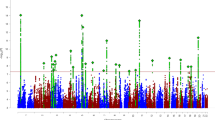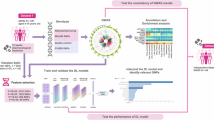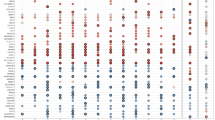Abstract
Attention-deficit hyperactivity disorder (ADHD) is a neurodevelopmental disorder with high heritability. At least 30% of patients diagnosed in childhood continue to suffer from ADHD during adulthood and genetic risk factors may play an essential role in the persistence of the disorder throughout lifespan. To date, genome-wide association studies (GWAS) of ADHD have been completed in seven independent datasets, six of which were pediatric samples and one on persistent ADHD using a DNA-pooling strategy, but none of them reported genome-wide significant associations. In an attempt to unravel novel genes for the persistence of ADHD into adulthood, we conducted the first two-stage GWAS in adults with ADHD. The discovery sample included 607 ADHD cases and 584 controls. Top signals were subsequently tested for replication in three independent follow-up samples of 2104 ADHD patients and 1901 controls. None of the findings exceeded the genome-wide threshold for significance (PGC<5e−08), but we found evidence for the involvement of the FBXO33 (F-box only protein 33) gene in combined ADHD in the discovery sample (P=9.02e−07) and in the joint analysis of both stages (P=9.7e−03). Additional evidence for a FBXO33 role in ADHD was found through gene-wise and pathway enrichment analyses in our genomic study. Risk alleles were associated with lower FBXO33 expression in lymphoblastoid cell lines and with reduced frontal gray matter volume in a sample of 1300 adult subjects. Our findings point for the first time at the ubiquitination machinery as a new disease mechanism for adult ADHD and establish a rationale for searching for additional risk variants in ubiquitination-related genes.
Similar content being viewed by others
Log in or create a free account to read this content
Gain free access to this article, as well as selected content from this journal and more on nature.com
or
References
Biederman J (2005). Attention-deficit/hyperactivity disorder: a selective overview. Biol Psychiatry 57: 1215–1220.
Biederman J, Faraone S, Milberger S, Curtis S, Chen L, Marrs A et al (1996). Predictors of persistence and remission of ADHD into adolescence: results from a four-year prospective follow-up study. J Am Acad Child Adolesc Psychiatry 35: 343–351.
Biederman J, Faraone SV (2005). Attention-deficit hyperactivity disorder. Lancet 366: 237–248.
Browning BL, Browning SR (2009). A unified approach to genotype imputation and haplotype phase inference for large data sets of trios and unrelated individuals. Am J Hum Genet 84: 210–223.
Carlson CS, Eberle MA, Rieder MJ, Yi Q, Kruglyak L, Nickerson DA (2004). Selecting a maximally informative set of single-nucleotide polymorphisms for association analysis using linkage disequilibrium. Am J Hum Genet 74: 106–120.
Cartegni L, Wang J, Zhu Z, Zhang MQ, Krainer AR (2003). ESEfinder: a web resource to identify exonic splicing enhancers. Nucleic Acids Res 31: 3568–3571.
Clayton D (2013). snpStats: SnpMatrix and XSnpMatrix classes and methods. R package version 1.14.0.
Cubillo A, Rubia K (2010). Structural and functional brain imaging in adult attention-deficit/hyperactivity disorder. Expert Rev Neurother 10: 603–620.
Chang Z, Lichtenstein P, Asherson PJ, Larsson H (2013). Developmental twin study of attention problems: high heritabilities throughout development. JAMA Psychiatry 70: 311–318.
Chou PY, Fasman GD (1974). Prediction of protein conformation. Biochemistry 13: 222–245.
de Bruijn DR, van Dijk AH, Pfundt R, Hoischen A, Merkx GF, Gradek GA et al (2010). Severe progressive autism associated with two de novo changes: a 2.6-Mb 2q31.1 deletion and a balanced t(14;21)(q21.1;p11.2) translocation with long-range epigenetic silencing of LRFN5 expression. Mol Syndromol 1: 46–57.
Fairbrother WG, Yeh RF, Sharp PA, Burge CB (2002). Predictive identification of exonic splicing enhancers in human genes. Science 297: 1007–1013.
Faraone SV, Biederman J, Feighner JA, Monuteaux MC (2000a). Assessing symptoms of attention deficit hyperactivity disorder in children and adults: which is more valid? J Consult Clin Psychol 68: 830–842.
Faraone SV, Biederman J, Spencer T, Wilens T, Seidman LJ, Mick E et al (2000b). Attention-deficit/hyperactivity disorder in adults: an overview. Biol Psychiatry 48: 9–20.
Faraone SV, Perlis RH, Doyle AE, Smoller JW, Goralnick JJ, Holmgren MA et al (2005). Molecular genetics of attention-deficit/hyperactivity disorder. Biol Psychiatry 57: 1313–1323.
Flood WD, Moyer RW, Tsykin A, Sutherland GR, Koblar SA (2004). Nxf and Fbxo33: novel seizure-responsive genes in mice. Eur J Neurosci 20: 1819–1826.
Franke B, Faraone SV, Asherson P, Buitelaar J, Bau CH, Ramos-Quiroga JA et al (2012). The genetics of attention deficit/hyperactivity disorder in adults, a review. Mol Psychiatry 17: 960–987.
Franke B, Neale BM, Faraone SV (2009). Genome-wide association studies in ADHD. Hum Genet 126: 13–50.
Gizer IR, Ficks C, Waldman ID (2009). Candidate gene studies of ADHD: a meta-analytic review. Hum Genet 126: 51–90.
Glessner JT, Wang K, Cai G, Korvatska O, Kim CE, Wood S et al (2009). Autism genome-wide copy number variation reveals ubiquitin and neuronal genes. Nature 459: 569–573.
González JR, Armengol L, Solé X, Guinó E, Mercader JM, Estivill X et al (2007). SNPassoc: an R package to perform whole genome association studies. Bioinformatics 23: 644–645.
Heinemeyer T, Wingender E, Reuter I, Hermjakob H, Kel AE, Kel OV et al (1998). Databases on transcriptional regulation: TRANSFAC, TRRD and COMPEL. Nucleic Acids Res 26: 362–367.
Hinney A, Scherag A, Jarick I, Albayrak O, Putter C, Pechlivanis S et al (2011). Genome-wide association study in German patients with attention deficit/hyperactivity disorder. Am J Med Genet B Neuropsychiatr Genet 156B: 888–897.
Holmans P, Green EK, Pahwa JS, Ferreira MAR, Purcell SM, Sklar P (2009). Gene ontology analysis of GWAS datasets provide insights into the biology of bipolar disorder. Am J Hum Genet 85: 13–24.
International HapMap Consortium (2003). The International HapMap Project. Nature 426: 789–796.
Kessler RC, Adler LA, Barkley R, Biederman J, Conners CK, Faraone SV et al (2005). Patterns and predictors of attention-deficit/hyperactivity disorder persistence into adulthood: results from the national comorbidity survey replication. Biol Psychiatry 57: 1442–1451.
Kooij JJ, Buitelaar JK, van den Oord EJ, Furer JW, Rijnders CA, Hodiamont PP (2005). Internal and external validity of attention-deficit hyperactivity disorder in a population-based sample of adults. Psychol Med 35: 817–827.
Kuntsi J, Rijsdijk F, Ronald A, Asherson P, Plomin R (2005). Genetic influences on the stability of attention-deficit/hyperactivity disorder symptoms from early to middle childhood. Biol Psychiatry 57: 647–654.
Lafreniere RG, Rouleau GA (2012). Identification of novel genes involved in migraine. Headache 52 (Suppl 2): 107–110.
Larsson H, Lichtenstein P, Larsson JO (2006). Genetic contributions to the development of ADHD subtypes from childhood to adolescence. J Am Acad Child Adolesc Psychiatry 45: 973–981.
Lasky-Su J, Anney RJ, Neale BM, Franke B, Zhou K, Maller JB et al (2008a). Genome-wide association scan of the time to onset of attention deficit hyperactivity disorder. Am J Med Genet B Neuropsychiatr Genet 147B: 1355–1358.
Lasky-Su J, Neale BM, Franke B, Anney RJ, Zhou K, Maller JB et al (2008b). Genome-wide association scan of quantitative traits for attention deficit hyperactivity disorder identifies novel associations and confirms candidate gene associations. Am J Med Genet B Neuropsychiatr Genet 147B: 1345–1354.
Lee SH, Ripke S, Neale BM, Faraone SV, Purcell SM, Perlis RH et al (2013). Genetic relationship between five psychiatric disorders estimated from genome-wide SNPs. Nat Genet 45: 984–994.
Lee PH, Shatkay H (2009). An integrative scoring system for ranking SNPs by their potential deleterious effects. Bioinformatics 25: 1048–1055.
Lesch KP, Timmesfeld N, Renner TJ, Halperin R, Roser C, Nguyen TT et al (2008). Molecular genetics of adult ADHD: converging evidence from genome-wide association and extended pedigree linkage studies. J Neural Transm 115: 1573–1585.
Lesch KP, Selch S, Renner TJ, Jacob C, Nguyen TT, Hahn T et al (2011). Genome-wide copy number variation analysis in attention-deficit/hyperactivity disorder: association with neuropeptide Y gene dosage in an extended pedigree. Mol Psychiatry 16: 491–503.
Liu JZ, McRae AF, Nyholt DR, Medland SE, Wray NR, Brown KM et al (2010). A versatile gene-based test for genome-wide association studies. Am J Hum Genet 87: 139–145.
Maldjian JA, Laurienti PJ, Kraft RA, Burdette JH (2003). An automated method for neuroanatomic and cytoarchitectonic atlas-based interrogation of fMRI data sets. Neuroimage 19: 1233–1239.
Mick E, Todorov A, Smalley S, Hu X, Loo S, Todd RD et al (2010). Family-based genome-wide association scan of attention-deficit/hyperactivity disorder. J Am Acad Child Adolesc Psychiatry 49: 898–905.e893.
Millar JK, Pickard BS, Mackie S, James R, Christie S, Buchanan SR et al (2005). DISC1 and PDE4B are interacting genetic factors in schizophrenia that regulate cAMP signaling. Science 310: 1187–1191.
Neale BM, Lasky-Su J, Anney R, Franke B, Zhou K, Maller JB et al (2008). Genome-wide association scan of attention deficit hyperactivity disorder. Am J Med Genet B Neuropsychiatr Genet 147B: 1337–1344.
Neale BM, Medland S, Ripke S, Anney RJ, Asherson P, Buitelaar J et al (2010a). Case-control genome-wide association study of attention-deficit/hyperactivity disorder. J Am Acad Child Adolesc Psychiatry 49: 906–920.
Neale BM, Medland SE, Ripke S, Asherson P, Franke B, Lesch KP et al (2010b). Meta-analysis of genome-wide association studies of attention-deficit/hyperactivity disorder. J Am Acad Child Adolesc Psychiatry 49: 884–897.
Nijmeijer JS, Arias-Vasquez A, Rommelse NN, Altink ME, Anney RJ, Asherson P et al (2010). Identifying loci for the overlap between attention-deficit/hyperactivity disorder and autism spectrum disorder using a genome-wide QTL linkage approach. J Am Acad Child Adolesc Psychiatry 49: 675–685.
Price TS, Simonoff E, Asherson P, Curran S, Kuntsi J, Waldman I et al (2005). Continuity and change in preschool ADHD symptoms: longitudinal genetic analysis with contrast effects. Behav Genet 35: 121–132.
Purcell S, Neale B, Todd-Brown K, Thomas L, Ferreira MA, Bender D et al (2007). PLINK: a tool set for whole-genome association and population-based linkage analyses. Am J Hum Genet 81: 559–575.
Ribases M, Hervas A, Ramos-Quiroga JA, Bosch R, Bielsa A, Gastaminza X et al (2008). Association study of 10 genes encoding neurotrophic factors and their receptors in adult and child attention-deficit/hyperactivity disorder. Biol Psychiatry 63: 935–945.
Ribases M, Ramos-Quiroga JA, Hervas A, Bosch R, Bielsa A, Gastaminza X et al (2009). Exploration of 19 serotoninergic candidate genes in adults and children with attention-deficit/hyperactivity disorder identifies association for 5HT2A, DDC and MAOB. Mol Psychiatry 14: 71–85.
Ripke S, O’Dushlaine C, Chambert K, Moran JL, Kahler AK, Akterin S et al (2013a). Genome-wide association analysis identifies 13 new risk loci for schizophrenia. Nat Genet 45: 1150–1159.
Ripke S, Wray NR, Lewis CM, Hamilton SP, Weissman MM, Breen G et al (2013b). A mega-analysis of genome-wide association studies for major depressive disorder. Mol Psychiatry 18: 497–511.
Rivero O, Sich S, Popp S, Schmitt A, Franke B, Lesch KP (2013). Impact of the ADHD-susceptibility gene CDH13 on development and function of brain networks. Eur Neuropsychopharmacol 23: 492–507.
Rommelse NN, Franke B, Geurts HM, Hartman CA, Buitelaar JK (2010). Shared heritability of attention-deficit/hyperactivity disorder and autism spectrum disorder. Eur Child Adolesc Psychiatry 19: 281–295.
Ruderfer DM, Fanous AH, Ripke S, McQuillin A, Amdur RL, Gejman PV et al (2013). Polygenic dissection of diagnosis and clinical dimensions of bipolar disorder and schizophrenia. Mol Psychiatry 19: 1017–1024.
Ryan MM, Lockstone HE, Huffaker SJ, Wayland MT, Webster MJ, Bahn S (2006). Gene expression analysis of bipolar disorder reveals downregulation of the ubiquitin cycle and alterations in synaptic genes. Mol Psychiatry 11: 965–978.
Sánchez-Mora C, Ribasés M, Ramos-Quiroga JA, Casas M, Bosch R, Boreatti-Hümmer A et al (2010). Meta-analysis of brain-derived neurotrophic factor p.Val66Met in adult ADHD in four European populations. Am J Med Genet B Neuropsychiatr Genet 153B: 512–523.
Silk T, Vance A, Rinehart N, Egan G, O’Boyle M, Bradshaw JL et al (2005). Fronto-parietal activation in attention-deficit hyperactivity disorder, combined type: functional magnetic resonance imaging study. Br J Psychiatry 187: 282–283.
Skol AD, Scott LJ, Abecasis GR, Boehnke M (2006). Joint analysis is more efficient than replication-based analysis for two-stage genome-wide association studies. Nat Genet 38: 209–213.
Stergiakouli E, Hamshere M, Holmans P, Langley K, Zaharieva I, Hawi Z et al (2012). Investigating the contribution of common genetic variants to the risk and pathogenesis of ADHD. Am J Psychiatry 169: 186–194.
Stranger BE, Forrest MS, Dunning M, Ingle CE, Beazley C, Thorne N et al (2007a). Relative impact of nucleotide and copy number variation on gene expression phenotypes. Science 315: 848–853.
Stranger BE, Nica AC, Forrest MS, Dimas A, Bird CP, Beazley C et al (2007b). Population genomics of human gene expression. Nat Genet 39: 1217–1224.
Stray LL, Kristensen O, Lomeland M, Skorstad M, Stray T, Tonnessen FE (2013). Motor regulation problems and pain in adults diagnosed with ADHD. Behav Brain Funct 9: 18.
Tai HC, Schuman EM (2008). Ubiquitin, the proteasome and protein degradation in neuronal function and dysfunction. Nat Rev Neurosci 9: 826–838.
Todd RD, Rasmussen ER, Neuman RJ, Reich W, Hudziak JJ, Bucholz KK et al (2001). Familiality and heritability of subtypes of attention deficit hyperactivity disorder in a population sample of adolescent female twins. Am J Psychiatry 158: 1891–1898.
Viechtbauer W (2010). Conducting meta-analyses in R with the metafor package. J Stat Softw 36: 1–48.
Wang K, Zhang H, Ma D, Bucan M, Glessner JT, Abrahams BS et al (2009). Common genetic variants on 5p14.1 associate with autism spectrum disorders. Nature 459: 528–533.
Wang Z, Rolish ME, Yeo G, Tung V, Mawson M, Burge CB (2004). Systematic identification and analysis of exonic splicing silencers. Cell 119: 831–845.
Xu Z, Taylor JA (2009). SNPinfo: integrating GWAS and candidate gene information into functional SNP selection for genetic association studies. Nucleic Acids Res 37: W600–W605.
Yang L, Neale BM, Liu L, Lee SH, Wray NR, Ji N et al (2013). Polygenic transmission and complex neuro developmental network for attention deficit hyperactivity disorder: genome-wide association study of both common and rare variants. Am J Med Genet B Neuropsychiatr Genet 162B: 419–430.
Zhao JH (2013). gap: Genetic Analysis Package. R package version 1.1-10.
Zhou K, Dempfle A, Arcos-Burgos M, Bakker SC, Banaschewski T, Biederman J et al (2008). Meta-analysis of genome-wide linkage scans of attention deficit hyperactivity disorder. Am J Med Genet B Neuropsychiatr Genet 147B: 1392–1398.
Acknowledgements
We thank all persons who kindly participated in this research. Part of the DNA extractions and genotyping was performed at the Spanish National Genotyping Centre (CEGEN-Barcelona). Principal investigators of the Nijmegen Biomedical Study are L.A.L.M. Kiemeney, J. de Graaf, A.L.M. Verbeek, D.W. Swinkels, and B. Franke. Principal investigators of the Cognomics Initiative are B. Franke, S. Fisher, G. Fernandez, H. Brunner, P. Hagoort, J. Buitelaar, H. van Bokhoven, and D. Norris. We are grateful to Silvia Fochs, Anna Sànchez, Maribel López, Nuria Pey, and Muriel Ferrer for their assistance in contacting the families and administering the questionnaires. Marta Ribasés is a recipient of a Miguel de Servet contract from the ‘Instituto de Salud Carlos III, Ministerio de Ciencia e Innovación’, Spain. Financial support was received from ‘Fundació La Marató de TV3’ (ref. 092330/31), ‘Instituto de Salud Carlos III-FIS’ (PI11/00571, PI11/01629, PI12/01139, PI041436, PI081151, Red INMA G03/176, and CB06/02/0041), ‘Plan Nacional Sobre Drogas’ (PNSD#2011-0080), ‘Agència de Gestió d’Ajuts Universitaris i de Recerca-AGAUR, Generalitat de Catalunya ‘(2014SGR1357, 2014SGR0932, and 1999SGR00241), Ministerio de Economía y Competitividad, Spain’ (SAF2012-33484), and ‘Departament de Salut’, Government of Catalonia, Spain. The Dutch part of the project was supported by the Hersenstichting Nederland and by a Vici grant of The Netherlands Organisation for Scientific Research (NWO) to Barbara Franke. The Dutch controls were derived from the Nijmegen Biomedical Study (www.nijmegenbiomedischestudie.nl); European Commission (ENGAGE project and grant agreement HEALTH-F4-2007-201413). This work made use of the BIG (Brain Imaging Genetics) database, first established in Nijmegen, The Netherlands, in 2007. This resource is now part of Cognomics (www.cognomics.nl), a joint initiative by researchers of the Donders Centre for Cognitive Neuroimaging, the Human Genetics and Cognitive Neuroscience departments of the Radboud University Medical Centre and the Max Planck Institute for Psycholinguistics in Nijmegen. The Cognomics Initiative is supported by the participating departments and centers and by external grants, ie, the Biobanking and Biomolecular Resources Research Infrastructure (The Netherlands; BBMRI-NL), the Hersenstichting Nederland and The Netherlands Organisation for Scientific Research (NWO). Funding for the Norwegian cohort was provided by the K.G. Jebsen Foundation, the Norwegian Research Council, and Regional Health Authority of Western Norway. The sample used in this study is part of the international multicentre persistent ADHD collaboration (IMpACT). IMpACT unites major research centres working on the genetics of ADHD persistence across the lifespan and has participants in the Netherlands, Germany, Spain, Norway, the United Kingdom, the United States, Brazil and Sweden. Principal investigators of IMpACT are: Barbara Franke (chair), Andreas Reif, Stephen V. Faraone, Jan Haavik, Bru Cormand, Antoni Ramos Quiroga, Philip Asherson, Klaus-Peter Lesch, Jonna Kuntsi, Claiton Bau, Jan Buitelaar, Stefan Johansson, Henrik Larsson, Alysa Doyle, and Eugenio Grevet.
Author information
Authors and Affiliations
Corresponding author
Additional information
Supplementary Information accompanies the paper on the Neuropsychopharmacology website
Supplementary information
PowerPoint slides
Rights and permissions
About this article
Cite this article
Sánchez-Mora, C., Ramos-Quiroga, J., Bosch, R. et al. Case–Control Genome-Wide Association Study of Persistent Attention-Deficit Hyperactivity Disorder Identifies FBXO33 as a Novel Susceptibility Gene for the Disorder. Neuropsychopharmacol 40, 915–926 (2015). https://doi.org/10.1038/npp.2014.267
Received:
Revised:
Accepted:
Published:
Issue date:
DOI: https://doi.org/10.1038/npp.2014.267
This article is cited by
-
Machine learning in attention-deficit/hyperactivity disorder: new approaches toward understanding the neural mechanisms
Translational Psychiatry (2023)
-
Elementary school teachers knowledge and attitude towards attention deficit-hyperactivity disorder in Gondar, Ethiopia: a multi-institutional study
Child and Adolescent Psychiatry and Mental Health (2021)
-
Genetics of ADHD: What Should the Clinician Know?
Current Psychiatry Reports (2020)
-
Transcription from a gene desert in a melanoma porcine model
Molecular Genetics and Genomics (2020)
-
Shared genetic background between children and adults with attention deficit/hyperactivity disorder
Neuropsychopharmacology (2020)



